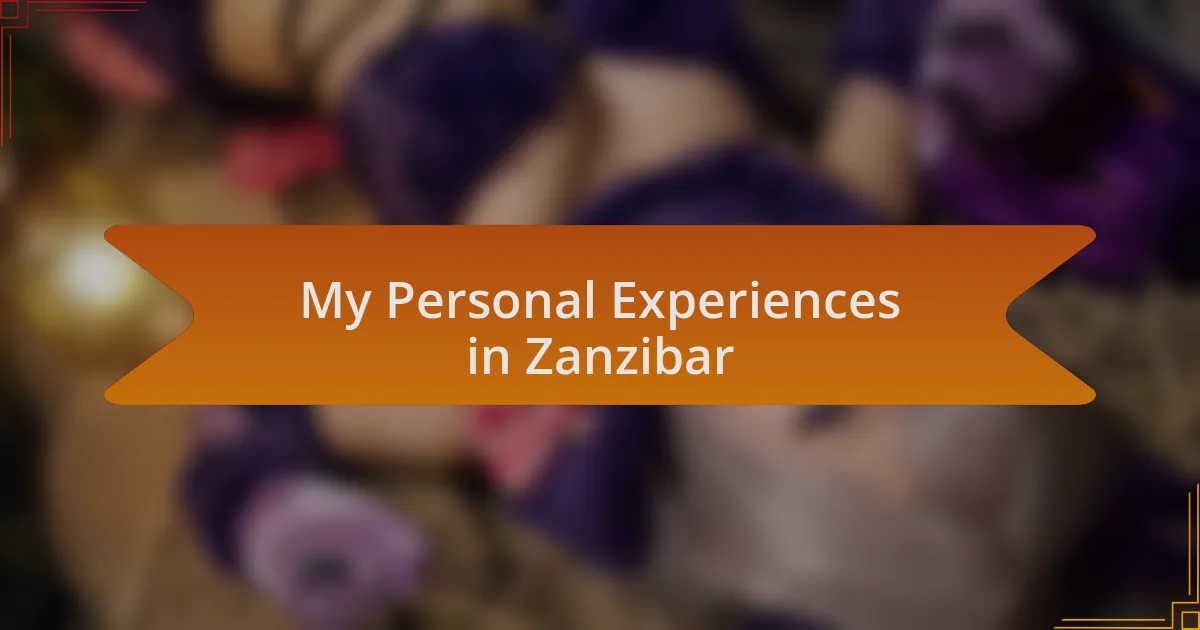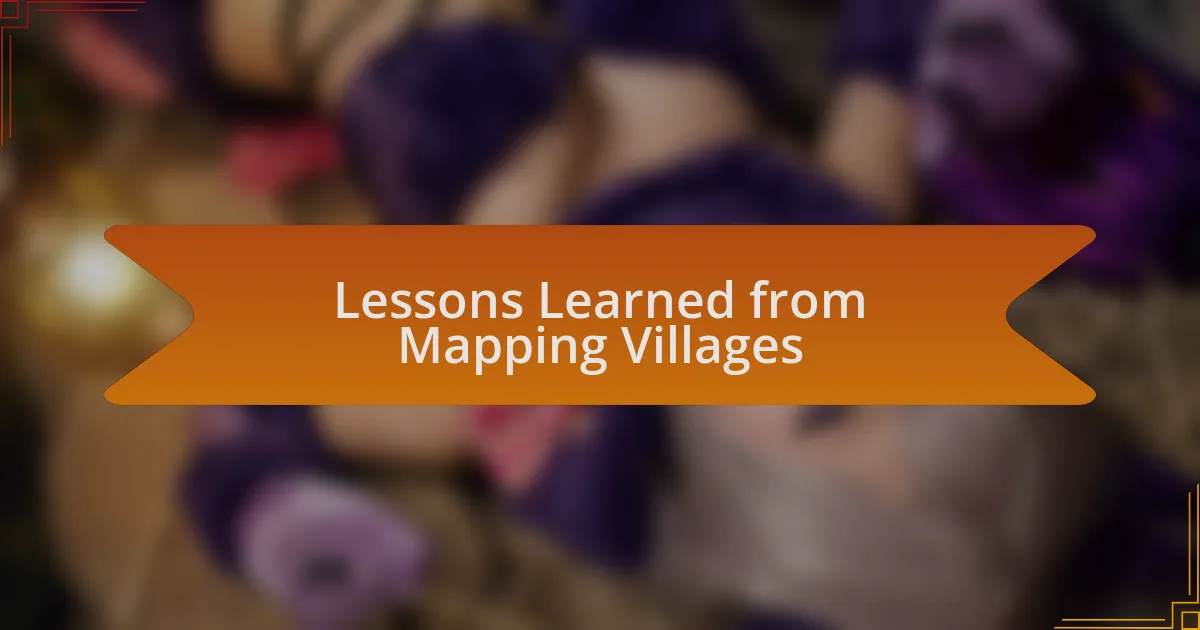Key takeaways:
- Drone mapping transforms the understanding of landscapes, revealing details that are often overlooked and aiding in both agriculture and preservation of cultural heritage.
- Zanzibar’s villages exhibit a rich tapestry of culture, with architecture influenced by diverse backgrounds, emphasizing the importance of preserving historical narratives.
- Effective drone mapping involves meticulous planning, understanding local weather patterns, and engaging with communities to enhance data collection and foster collaboration.
- Experiencing village life through local interactions deepens respect for the environment and highlights the connection between culture, tradition, and sustainable progress.

Introduction to Drone Mapping
Drone mapping offers a groundbreaking way to capture spatial data from a bird’s-eye view, transforming our understanding of landscapes. I remember the first time I witnessed a drone soaring over a village; it felt almost magical as it revealed details that the naked eye could easily miss. Have you ever thought about how much we can learn from just a different perspective?
The technology behind drone mapping is impressive, combining high-resolution cameras and GPS to create accurate topographical maps. One creamy afternoon, I stood amazed as the drone swept over lush fields and winding paths, turning the ordinary into a stunning visual narrative. It struck me how this modern tool not only aids in agriculture but can also preserve the rich history of Zanzibar’s villages.
As I delve deeper into drone mapping, I’m consistently intrigued by its ability to demystify complex terrains. It’s like peeling back layers of history; each image tells a story. How can we maximize this technology for community development and environmental conservation? This is just one of the many questions I ponder as I explore Zanzibar’s captivating landscapes.

Overview of Zanzibar’s Villages
Zanzibar’s villages are a tapestry of culture, history, and vibrant community life. Each village has its unique character, shaped by its location and the traditions of its people. I recall strolling through the narrow alleys of Paje, where the scent of spices lingered in the air, reminding me of the island’s rich trade heritage. Have you ever walked through a place that felt like a story waiting to be told?
The architecture in Zanzibar’s villages reflects a blend of African, Arab, and Indian influences, creating a distinctive aesthetic. I was particularly mesmerized by the intricate wooden doors and coral stone buildings, each telling tales of generations past. It made me wonder how these structures withstand the test of time, and how drone mapping might help preserve these architectural gems for future generations.
Living in these villages offers a glimpse into daily life that feels both simple and profound. I remember chatting with a fisherman in Nungwi, who shared stories of the sea and his deep respect for nature. It struck me how interconnected life is here; the rhythm of the villagers’ existence reflects the tides and seasons. How can we ensure that their stories remain part of the wider narrative of Zanzibar as it evolves?

Techniques for Effective Drone Mapping
When undertaking drone mapping in Zanzibar’s villages, one of the most effective techniques I’ve found is planning flight paths meticulously. I remember the first time I mapped a village near Stone Town; I created a detailed grid that ensured I captured every angle of the terrain. This attention to detail not only optimizes data collection but also enhances the quality of the imagery, revealing features that might be overlooked otherwise. Have you considered how a well-planned flight path could uncover hidden gems within a community?
Another essential technique is understanding the local weather patterns. During my initial flights, I encountered unexpected gusts that challenged my control of the drone. This experience taught me to monitor weather forecasts closely, realizing that calm days often yield the best results for capturing precise imagery. Knowing when to fly can make all the difference—imagine how frustrating it must be to miss key opportunities due to poor visibility!
Lastly, effective collaboration with local communities enriches the mapping process. I found that engaging with villagers not only provided me with invaluable local knowledge but also fostered trust and support for my work. Their insights into specific areas of interest can guide drone operations, enhancing the overall quality of the mapping project. Have you ever considered how powerful local participation could be when documenting cultural heritage?

My Personal Experiences in Zanzibar
Exploring Zanzibar was more than just a mapping project for me; it felt like stepping into a vibrant tapestry of life. One afternoon, while flying over a small village, I was captivated by the lively markets below. The colors, sounds, and scents blended into a sensory experience that no photograph could truly capture. Reflecting on this, I wondered how often we rush through experiences without taking time to appreciate the rich stories that surround us.
During my time in Zanzibar, I had the chance to sit down with local fishermen who shared tales of their daily catch. Their passion was palpable, and I realized the connection between their livelihood and the land they worked. Listening to their stories instilled in me a deeper respect for the environment I was mapping. Have you ever connected with someone whose life is so intertwined with their surroundings that it reshapes your perspective?
One of my most memorable moments occurred when I flew my drone over a village during sunset. The golden hues casting shadows over the thatched rooftops created a breathtaking scene. As I watched the sun dip below the horizon, I felt an overwhelming sense of gratitude. In those moments, mapping wasn’t just about collecting data; it was about capturing the essence of Zanzibar. What have you found when you take the time to simply pause and observe?

Lessons Learned from Mapping Villages
Mapping the villages of Zanzibar offered me unexpected insights into community dynamics. One afternoon, I assisted locals in documenting their agricultural fields. This hands-on experience taught me that technology can not only collect data but also foster collaboration and engagement within communities. Have you ever witnessed a simple act of sharing knowledge evolve into a collective goal?
As I mapped the intricate layouts of the villages, I recognized the importance of cultural context. Every pathway and structure had a story intricately connected to the people living there. I felt a responsibility to represent these narratives authentically. Reflecting on that, I pondered how we can sometimes overlook the significance of place in our work. How often do we take the time to ask locals about their history or significance of their landmarks?
Another lesson came while capturing aerial footage of a village festival. The vibrancy of the celebrations, filled with dancing and laughter, illustrated the deep-rooted traditions that thrived despite modernization. Witnessing this allowed me to appreciate the delicate balance between progress and preservation. What does it mean for you to engage with traditions that shape communities? That day reinforced my belief that mapping is as much about honoring culture as it is about data.